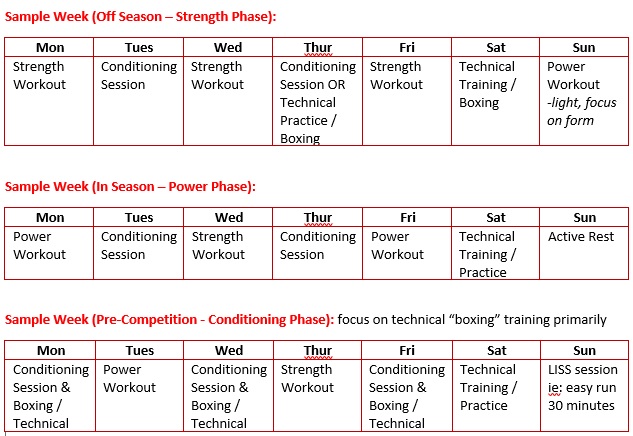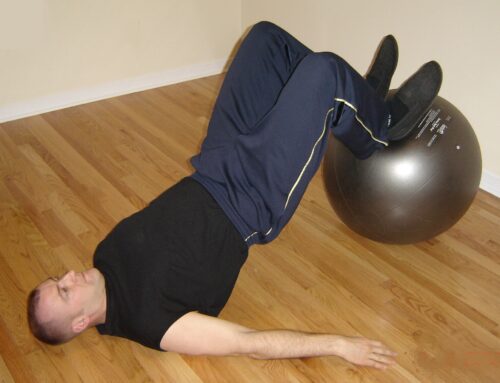In this article I want to cover a few fundamentals of strength and conditioning for combat sports that I recently shared with my friend Jason from Precision Striking. First I’ll discuss exercises to develop base strength, then move on to power movements and conditioning exercises.

But before I get into that, here are some key points related to this topic.
Key Points:
- Use primarily body weight and free weight exercises.
- Choose mostly compound, multi-joint movements.
- Perform a lighter warm-up set before progressing to the more challenging working sets.
- Build a solid strength base first, before progressing to explosive power movements.
- Progress gradually: increase weight (load), reps, sets, etc, slowly as your body adapts.
- Train the body in balance, considering both pushing and pulling movements.
- Think “Purposeful” vs “Functional”.
- “Sport-Specific” Exercise is often misunderstood or misused. Choose exercises that have a carry-over to your athletic performance, but don’t try to mimic the actual sport activity with added resistance.
- Start each workout with a Dynamic Warmup and Core Activation (Click to view videos)
Here’s the video I made with Jason demonstrating some of the key principles of strength, power, and conditioning for fighters:
Strength Days:
The point of the strength-focused workouts is to reduce risk of injury, build or maintain muscle (which is important when gaining or losing body weight for your weight class), and to develop a strength base that will transfer to greater power output later: Stronger muscles can be trained to move faster… so when you make contact with your opponent it will feel like he tried kissing the express train (“yeah, let’s start building some hurtin’ bombs!” – Rocky Balboa, 2006). Some points to consider are as follows:
- Slow controlled repetitions focusing on contracting the muscles involved.
- 3 to 6 sets of 6 to 12 reps
- 60-90 seconds between supersets
- Take last set to complete fatigue
- Progressively increase total volume (ie: number of sets) and resistance used and adjust repetitions accordingly.
Sample Full Body Workout:
SuperSet A:
A 1) Pullups (or inverted rows)
A 2) Dips (or pushups)
SuperSet B:
B 1) Lunge Variation
B 2) Stiff Leg Deadlift OR Single Leg Deadlift
SuperSet C:
C 1) Hanging Leg Raises
C 2) Ab Wheel Rollouts
Then repeat the cycle with more challenging resistance / exercise variations.
Power Days:
Once you develop a solid strength base you can introduce power workouts. These sessions train you to become faster and more explosive with specific movement patterns. These exercises will also improve movement efficiency and motor control. To avoid injury, when you first introduce these power movements use a lighter load with higher reps, to practice strict form and get used to the exercises. As you increase the weight, remember to focus on moving with explosiveness… not grinding with heavy weights. Some points to consider:
- Quick, smooth, explosive movements.
- Start with lighter weights and higher reps to get used to the exercises and work on form.
- 4 to 6 sets of 3 to 6 reps
- 2 minutes of rest between sets. (Straight sets, no supersets)
- Only use weight you are able to move quickly. Focus on speed vs load. If you start to slow down or fatigue during a set, the set is done!
- Avoid complete fatigue / failure.
Sample Workout:
- Jump Squats
- Push Press
- High Pulls
- Plyo Pushups
- Power Twists

Once you can complete all sets explosively for 6 reps, increase load and work up from 3 reps again.
Conditioning Days:
Use High Intensity Interval Training (HIIT) vs Low Intensity Steady State (LISS) cardio.
Here’s a great article by Ross Enamait about why the old-school mentality that boxers need to run long distances for their aerobic conditioning is out-dated: The Right Way to Train for Boxing. Don’t waste hours of your time running for miles and miles. Boxing is a primarily a power sport and considering the duration of each round and the explosive effort involved, you are better off training your endurance or conditioning using interval training.
- Keep sessions brief and intense (10 to 20 minutes)
- Alternate hard/intense “sprint-style” intervals with slower/easier recovery intervals
- Start with alternating 30 seconds hard : 1 minute easy
- Progress by increasing hard interval duration (30 –> 45 seconds) and / or reducing easy interval duration (60 –> 30 seconds) as your conditioning improves.
- Can use a variety of conditioning “Cardio” exercises ie: burpees, mountain climbers, skipping rope, jumping jacks, sprints, stationary bike, ergometer rower, sled drag, battle rope, hammer slams, medicine ball slams, etc.
- NOTE: consider an intense sparring, pad work, or heavy bag session as a conditioning workout. Adjust your total number of sessions accordingly to avoid overtraining.
*Boxing / Technical work can include sparring, pad work, heavy bag, speed bag, skipping rope, shadow boxing, technical drills, etc.
Check out the video below for some boxing pad work drills:

If you’re a fighter or you coach fighters, I hope you found this article and video helpful and it provided you with some ideas for putting together your own strength and conditioning plan for the combat arts.






